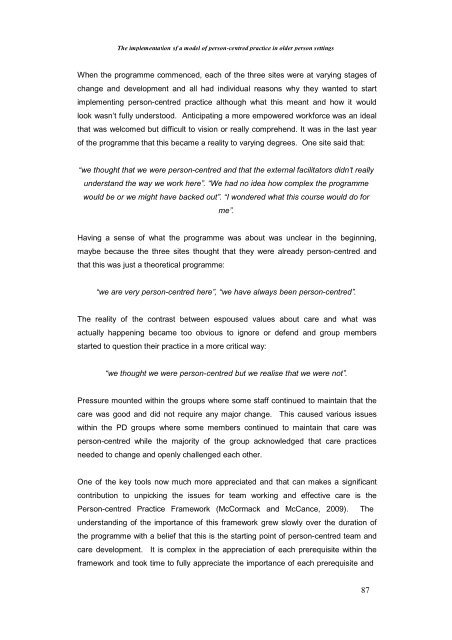The Implementation of a Model of Person-Centred Practice In Older ...
The Implementation of a Model of Person-Centred Practice In Older ...
The Implementation of a Model of Person-Centred Practice In Older ...
Create successful ePaper yourself
Turn your PDF publications into a flip-book with our unique Google optimized e-Paper software.
<strong>The</strong> implementation <strong>of</strong> a model <strong>of</strong> person-centred practice in older person settings<br />
When the programme commenced, each <strong>of</strong> the three sites were at varying stages <strong>of</strong><br />
change and development and all had individual reasons why they wanted to start<br />
implementing person-centred practice although what this meant and how it would<br />
look wasn’t fully understood. Anticipating a more empowered workforce was an ideal<br />
that was welcomed but difficult to vision or really comprehend. It was in the last year<br />
<strong>of</strong> the programme that this became a reality to varying degrees. One site said that:<br />
“we thought that we were person-centred and that the external facilitators didn’t really<br />
understand the way we work here”. “We had no idea how complex the programme<br />
would be or we might have backed out”. “I wondered what this course would do for<br />
me”.<br />
Having a sense <strong>of</strong> what the programme was about was unclear in the beginning,<br />
maybe because the three sites thought that they were already person-centred and<br />
that this was just a theoretical programme:<br />
“we are very person-centred here”, “we have always been person-centred”.<br />
<strong>The</strong> reality <strong>of</strong> the contrast between espoused values about care and what was<br />
actually happening became too obvious to ignore or defend and group members<br />
started to question their practice in a more critical way:<br />
“we thought we were person-centred but we realise that we were not”.<br />
Pressure mounted within the groups where some staff continued to maintain that the<br />
care was good and did not require any major change. This caused various issues<br />
within the PD groups where some members continued to maintain that care was<br />
person-centred while the majority <strong>of</strong> the group acknowledged that care practices<br />
needed to change and openly challenged each other.<br />
One <strong>of</strong> the key tools now much more appreciated and that can makes a significant<br />
contribution to unpicking the issues for team working and effective care is the<br />
<strong>Person</strong>-centred <strong>Practice</strong> Framework (McCormack and McCance, 2009). <strong>The</strong><br />
understanding <strong>of</strong> the importance <strong>of</strong> this framework grew slowly over the duration <strong>of</strong><br />
the programme with a belief that this is the starting point <strong>of</strong> person-centred team and<br />
care development. It is complex in the appreciation <strong>of</strong> each prerequisite within the<br />
framework and took time to fully appreciate the importance <strong>of</strong> each prerequisite and<br />
87
















